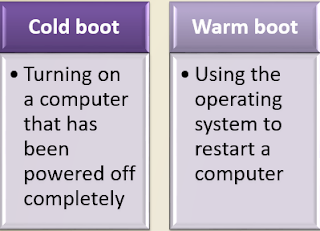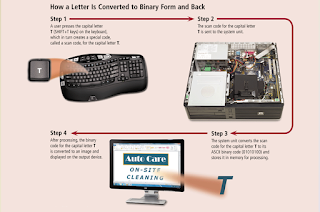Enterprise Computing
Enterprise computing involves the use of computers in networks, such as LANs and WANs, or a series of interconnected networks that encompass a variety of different operating systems, protocols, and network architectures
Types of enterprises:
- Retail.
- Manufacturing.
- Service.
- Wholesale.
- Government.
- Educational.
- Transportation.
The common categories in an enterprise are:
1) Executive management.
2) Middle management.
3) Operational management.
4) Non-management employess.
Enterprise information is the information gathered in the ongoing operations of an enterprise-sized organization
- Business intelligence
- Business process management
- Business process automation
Managers coordinate resources by performing four activities
Planning > Organizing> Leading> Controlling> Planning
Information Systems in the Enterprise
An information system is a set of hardware, software, data, people, and procedures that work together to produce information
- Accounting and Finance
1)-Accounting software manages the everyday transaction.
2)-Billing software helps the company reconcile purchases with customer payments.
3)-The financial software helps managers budget, forecast, and analyze.
- Human Resources
1)-Human resources information system (HRIS) manages one or more human resources functions.
2)-Employee relationship management systems manage communication between employees and the business.
- Engineering or Product Development
1)-Computer-aided design (CAD) uses a computer and special software to aid in engineering, drafting, and design.
2)-Computer-aided engineering (CAE) uses computers to test product designs
- Manufacturing
1)-Computer-aided manufacturing (CAM) is the use of computers to control production equipment.
2)-Computer-integrated manufacturing (CIM) uses the computer to integrated the many different operations of the manufacturing process.
3)-Material Requirements Planning (MRP) uses software to help monitor and control processes related to production.
4)-Manufacturing Resource Planning II (MRP II) is an extension of MRP and also includes software helps in scheduling
5)-Quality control system helps an organization maintain or improve the quality of its products or services.
Marketing-Marketing information system serves as a central repository for the tasks of a marketing department.
Sales-Sales force automation (SFA) software equips traveling salespeople with the electronic tools they need to be more productive.
Distribution-Distribution system provide forecasting for inventory control, manage and track shipping of products and provide information and analysis on inventory in a warehouse.
Customer service-Customer interaction management (CIM) software manages the day-to-day interactions with customers.
Information Technology
- Information Technology
-Makes technology decisions for the enterprise in the case like whether to build or buy new information system and when a computer or information system has outlived its useful life.
-Web Site Management Programs- collect data designed to help organizations make informed decisions regarding their Web presence.
-Office Information System (OIS)- oriented to word processing, electronic mail, and other similar office functions.
-Transaction Processing System (TPS)- for business transactions involving the collection, modification, and retrieval of all transaction data.
-Management Information System (MIS)- focuses on management of information systems to provide efficiency and effectiveness of strategic decision making.
-Decision Support System (DSS)- a set of related computer programs and data required to assists with analysis and decision making within an organization.
-Expert System- a piece of software programmed using artificial intelligence. It uses the database of expert knowledge to offer advice or make the decision. For example, it is the help button found in our operating system.
-Integrated Information System (IIS)- an array of multiple information sets linked together in an organized way. This contains three processes:
- Customer relationship management manages information about customers, interactions with customers, past purchases, and interests.
- Enterprise resource planning provides centralized, integrated software to help manage and coordinate ongoing activities.
- Content management systems are information systems that combine database, software, and procedures.
Technologies used in enterprise:
- Portals- a collection of links, content and services presented on a Web page that are interesting for a particular job function/
- Data Warehouse- a huge database that stores and manages the data required to analyse historical and current transactions.
- Electronic Data Interchange (EDI)- a set of standards that control the transfer of business data and information among computers both within and among enterprise.
- Extranet- a portion of a company's network that allows customers or suppliers of a company to access parts of an enterprise's intranet.
- Web Services- allow businesses to create products and B2B interactions over the Internet.
- Document Management System (DMS)- allows for storage and management of a company's documents.
- Workflow- a defined process that identifies the specific set of steps involved in completing a particular project or business process.
- Virtual Private Network- allow customers or vendors to connect to company network server in a private network connection.
Virtualisation- practice of sharing or pooling computing resources.
A) Server virtualisation- physical server can be divided into many virtual servers.
B) Storage virtualisation- single logical storage device can be created from many physical storage devices.
Cloud computing- an Internet service that provides computing needs to computer users.
A) Grid computing- combines many servers and/or personal computers on a network to act as one large computer.
Enterprise Hardware
- Enterprise hardware allows large organizations to manage and store information and data using devices geared for:
- Heavy use
- Maximum availability
- Maximum efficiency
- RAID duplicates data and implements duplication in different ways
- Network attached storage (NAS) is a server that provides storage to users and information systems attached to the network
- A storage area network (SAN) is a high-speed network that provides storage to other servers to which it is attached
- An enterprise storage system is a strategy that focuses on the availability, protection, organization, and backup of storage in a company
- Goal is to consolidate storage
- A blade server packs a complete computer server on a single card (called a blade) rather than a system unit
- The individual blades insert in a blade server chassis
- A thin client is a small terminal-like computer that mostly relies on a server for data storage and processing
- The processing for a thin client usually is done on a server
High availability system- continues running and performing tasks for at least 99 percent of the time. It include hot-swapping and redundant components.
Scalability- measures of how well a computer hardware, software or an information system can grow to meet increasing performance demands.
Interoperability- ability for an information system to share information with other information systems within an enterprise.
Types of backup methods:
1) Full- fastest recovery method. All files are saved. Disadvantage is longest backup time.
2) Differential- fast backup method and require minimal storage. Disadvantage is recovery is time consuming because the last full backup plus differential backup are needed.
3) Incremental- fastest backup method and require minimal storage. Only most recent changes saved. Disadvantage is recovery is most time consuming because the last full backup and all incremental backups since the last full backup are needed.
4) Selective- fast backup method which provide great flexibility. Disadvantage is difficult to mange individual file backups.
5) Continuous- the only real time backup and recovery of data is very fast. Disadvantage is very expensive and requires a great amount of storage.
Disaster recovery plan- a written plan describing the steps a company would take to restore computer operations in the event of a disaster. Contains four major components which are Emergency plan, Backup plan, Recovery plan and Test plan.


















